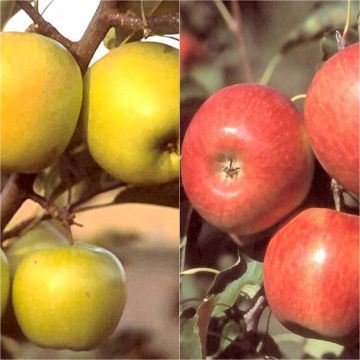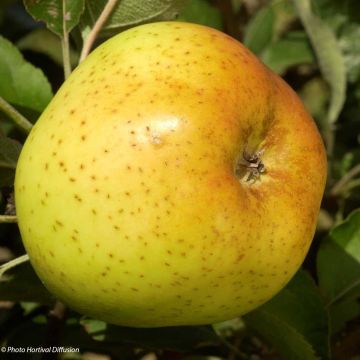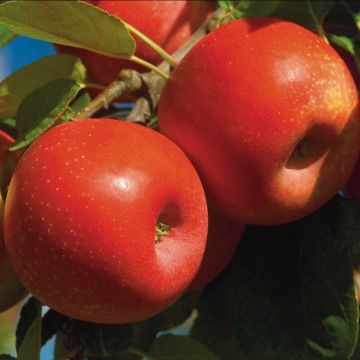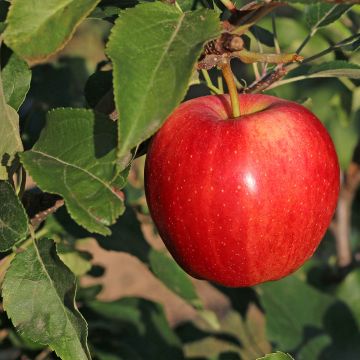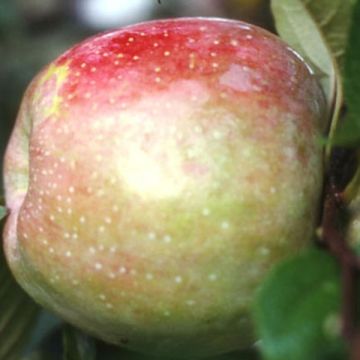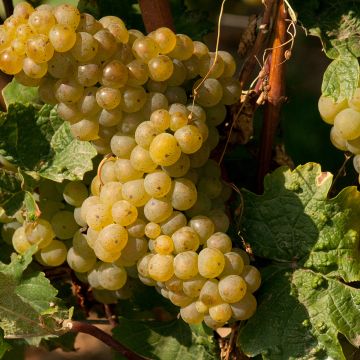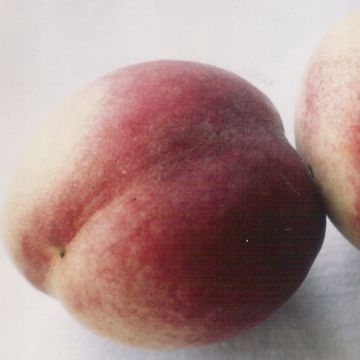

Pommier Museau de Lièvre


Pommier Museau de Lièvre
Apple Tree Museau de Lièvre - Malus domestica
Malus domestica Museau de Lièvre
Apple, Orchard apple, Table apple, Cultivated apple
The apple tree arrived quickly, well pruned, and we are looking forward to tasting the first two apples!
Anne, 28/08/2024
Why not try an alternative variety in stock?
View all →This plant carries a 6 months recovery warranty
More information
We guarantee the quality of our plants for a full growing cycle, and will replace at our expense any plant that fails to recover under normal climatic and planting conditions.
Oversize package: home delivery by special carrier from €6.90 per order..
Express home delivery from €8.90.
From €5.90 for pickup delivery and €6.90 for home delivery
Express home delivery from €8.90.
Oversize package: home delivery by special carrier from €6.90 per order..
Express home delivery from €8.90.

Description
The Apple 'Museau de Lièvre' is an excellent old variety, said to originate from Alos, in Ariège. Productive, it is highly appreciated for the original and characteristic shape of its elongated, conical fruits, which indeed resemble a hare's muzzle. Hardy, the Apple Museau de Lièvre can easily withstand temperatures as low as -20 °C (- 4°F) and usually blooms from April to May. This apple tree is not self-fertile, so to bear abundant fruit, it should be planted near varieties that flower at the same time, such as 'Reine de Reinettes', 'Reinette de Caux', or 'Golden Delicious'.
The apple tree (Malus domestica) is a fruit tree that belongs to the Rosaceae family. It is cultivated almost everywhere in the world and includes countless old and modern varieties that produce apples of varying sizes and degrees of sweetness or acidity. Apple trees are native to Europe, where their presence has been documented since ancient times. They are hardy, sometimes even down to -30 °C (- 22°F) for the most resistant varieties, and can be grown anywhere.
The apple tree bears white or pinkish-white flowers in spring, grouped in corymbs. The flowers of the apple tree have five petals and surround a core composed of around 20 stamens. They give rise to fleshy, spherical fruits (technically drupes) and filled with seeds. Their colour, size, flavour, and storage duration vary depending on the variety. These fruits are harvested in September. They are covered with a yellow skin tinged with salmon. Their delicious quality flesh is white, tender, delicate, and juicy. It has a sweet flavour, slightly tangy, with a pleasant hint of melon. It is an ideal table apple to bite into and can also be used to make apple juice. These apples can be stored until December.
The apple tree leaves are deciduous and arranged alternately on the branches. Their lamina is ovate and dentate. They have a dark green upper surface and a whitish lower surface, slightly velvety.
The apple tree can be grown in all climates but particularly appreciates temperate regions, preferably humid ones. It thrives in full sun in reasonably moist and rich soil. It is traditionally planted in the heart of an orchard but can also be grown as a standalone tree or hedge.
Domestic apple trees should be no larger than ten metres high and almost as wide. The size may even be much shorter, depending on the rootstock's vigour. This fruit tree generally presents as a tall trunk that naturally spreads out. It can take on various forms (goblet, half-standard, standard...) and be trained in numerous ways (column, cordon, espalier...). It is an easy fruit tree that requires at least some thinning pruning. Proper fruiting pruning will prevent alternate bearing (fruiting every other year). An annual or biennial application of well-decomposed compost also enhances apple tree productivity.
Report an error about the product description
Apple Tree Museau de Lièvre - Malus domestica in pictures




Plant habit
Fruit
Flowering
Foliage
Botanical data
Malus
domestica
Museau de Lièvre
Rosaceae
Apple, Orchard apple, Table apple, Cultivated apple
Cultivar or hybrid
Other Apple trees
Planting and care
Choose a sunny location for your Apple tree 'Hare's Snout'; the soil can be slightly chalky or acidic but not excessively. Dig a large planting hole at least three times the volume of the root ball. Add organic matter (potting soil, compost...) and a base fertilizer such as crushed horn. Do not bury the graft collar. Stake if necessary. Water generously, even in winter, even if it rains. Fruit trees are ideally planted between October and March, outside of the freezing period. Container-grown plants can be planted year-round, except during periods of extra frost.
In winter, you can add a small shovelful of wood ash, rich in potassium, to improve fruiting. Keep an eye out for aphids during the season. A white felting due to a fungus, powdery mildew, may appear on the leaves in summer, but this is not detrimental to fruit development in gardens. Harvesting takes place in September. Only keep fruit that has been picked. Apples should be stored stalk-side down, on trays or crates. Choose a place that is preferably completely dark, dry and cool, but frost-free.
Planting period
Intended location
Care
-
, onOrder confirmed
Reply from on Promesse de fleurs
Ancient and local varieties
Haven't found what you were looking for?
Hardiness is the lowest winter temperature a plant can endure without suffering serious damage or even dying. However, hardiness is affected by location (a sheltered area, such as a patio), protection (winter cover) and soil type (hardiness is improved by well-drained soil).

Photo Sharing Terms & Conditions
In order to encourage gardeners to interact and share their experiences, Promesse de fleurs offers various media enabling content to be uploaded onto its Site - in particular via the ‘Photo sharing’ module.
The User agrees to refrain from:
- Posting any content that is illegal, prejudicial, insulting, racist, inciteful to hatred, revisionist, contrary to public decency, that infringes on privacy or on the privacy rights of third parties, in particular the publicity rights of persons and goods, intellectual property rights, or the right to privacy.
- Submitting content on behalf of a third party;
- Impersonate the identity of a third party and/or publish any personal information about a third party;
In general, the User undertakes to refrain from any unethical behaviour.
All Content (in particular text, comments, files, images, photos, videos, creative works, etc.), which may be subject to property or intellectual property rights, image or other private rights, shall remain the property of the User, subject to the limited rights granted by the terms of the licence granted by Promesse de fleurs as stated below. Users are at liberty to publish or not to publish such Content on the Site, notably via the ‘Photo Sharing’ facility, and accept that this Content shall be made public and freely accessible, notably on the Internet.
Users further acknowledge, undertake to have ,and guarantee that they hold all necessary rights and permissions to publish such material on the Site, in particular with regard to the legislation in force pertaining to any privacy, property, intellectual property, image, or contractual rights, or rights of any other nature. By publishing such Content on the Site, Users acknowledge accepting full liability as publishers of the Content within the meaning of the law, and grant Promesse de fleurs, free of charge, an inclusive, worldwide licence for the said Content for the entire duration of its publication, including all reproduction, representation, up/downloading, displaying, performing, transmission, and storage rights.
Users also grant permission for their name to be linked to the Content and accept that this link may not always be made available.
By engaging in posting material, Users consent to their Content becoming automatically accessible on the Internet, in particular on other sites and/or blogs and/or web pages of the Promesse de fleurs site, including in particular social pages and the Promesse de fleurs catalogue.
Users may secure the removal of entrusted content free of charge by issuing a simple request via our contact form.
The flowering period indicated on our website applies to countries and regions located in USDA zone 8 (France, the United Kingdom, Ireland, the Netherlands, etc.)
It will vary according to where you live:
- In zones 9 to 10 (Italy, Spain, Greece, etc.), flowering will occur about 2 to 4 weeks earlier.
- In zones 6 to 7 (Germany, Poland, Slovenia, and lower mountainous regions), flowering will be delayed by 2 to 3 weeks.
- In zone 5 (Central Europe, Scandinavia), blooming will be delayed by 3 to 5 weeks.
In temperate climates, pruning of spring-flowering shrubs (forsythia, spireas, etc.) should be done just after flowering.
Pruning of summer-flowering shrubs (Indian Lilac, Perovskia, etc.) can be done in winter or spring.
In cold regions as well as with frost-sensitive plants, avoid pruning too early when severe frosts may still occur.
The planting period indicated on our website applies to countries and regions located in USDA zone 8 (France, United Kingdom, Ireland, Netherlands).
It will vary according to where you live:
- In Mediterranean zones (Marseille, Madrid, Milan, etc.), autumn and winter are the best planting periods.
- In continental zones (Strasbourg, Munich, Vienna, etc.), delay planting by 2 to 3 weeks in spring and bring it forward by 2 to 4 weeks in autumn.
- In mountainous regions (the Alps, Pyrenees, Carpathians, etc.), it is best to plant in late spring (May-June) or late summer (August-September).
The harvesting period indicated on our website applies to countries and regions in USDA zone 8 (France, England, Ireland, the Netherlands).
In colder areas (Scandinavia, Poland, Austria...) fruit and vegetable harvests are likely to be delayed by 3-4 weeks.
In warmer areas (Italy, Spain, Greece, etc.), harvesting will probably take place earlier, depending on weather conditions.
The sowing periods indicated on our website apply to countries and regions within USDA Zone 8 (France, UK, Ireland, Netherlands).
In colder areas (Scandinavia, Poland, Austria...), delay any outdoor sowing by 3-4 weeks, or sow under glass.
In warmer climes (Italy, Spain, Greece, etc.), bring outdoor sowing forward by a few weeks.



































